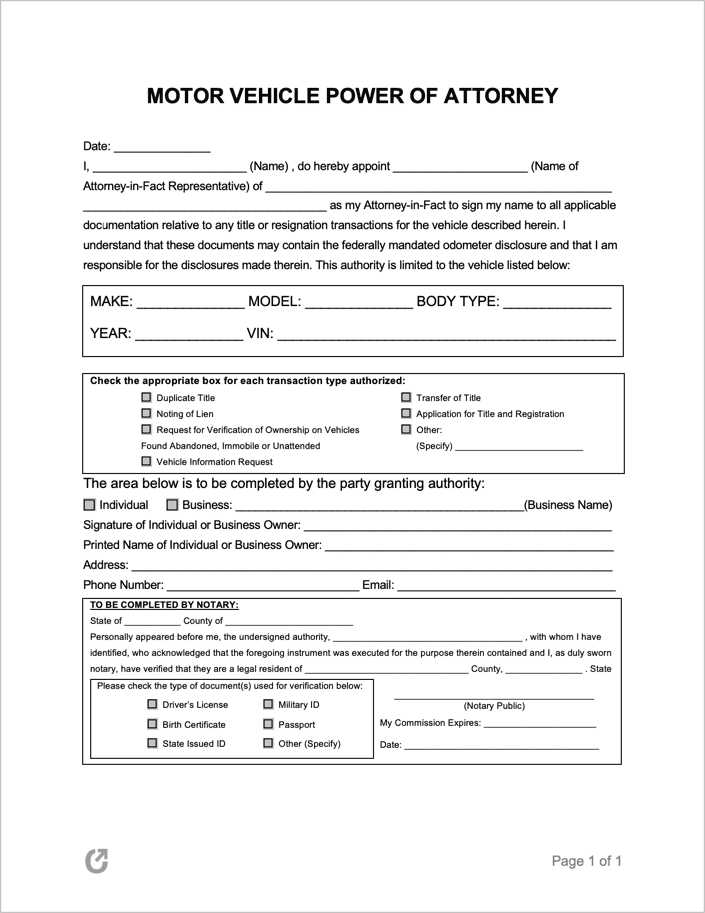Motor Vehicle Power of Attorney Forms
A motor vehicle power of attorney form allows an automobile owner to delegate car-related tasks to a trusted person. The duties include registering and titling the vehicle, transferring the title, transporting it, or allowing someone to repair it. Many states have published a form for residents to use when assigning tasks. Individuals living in a state without an official form can use a generic document as long as it contains the information needed, such as the agent’s personal details, a description of the car, and a list of the responsibilities.
Summary
|
Motor Vehicle Power of Attorneys by State
- Alabama
- Alaska
- Arizona
- Arkansas
- California
- Colorado
- Connecticut
- Delaware
- Florida
- Georgia
- Hawaii
- Idaho
- Illinois
- Indiana
- Iowa
- Kansas
- Kentucky
- Louisiana
- Maine
- Maryland
- Massachusetts
- Michigan
- Minnesota
- Mississippi
- Missouri
- Montana
- Nebraska
- Nevada
- New Hampshire
- New Jersey
- New Mexico
- New York
- North Carolina
- North Dakota
- Ohio
- Oklahoma
- Oregon
- Pennsylvania
- Rhode Island
- South Carolina
- South Dakota
- Tennessee
- Texas
- Utah
- Vermont
- Virginia
- Washington
- West Virginia
- Wisconsin
- Wyoming
What is a Motor Vehicle Power of Attorney?
A motor vehicle power of attorney is a legal form that sets out an arrangement whereby a motor vehicle owner will appoint another party (called the agent or attorney-in-fact) to handle specific tasks related to their vehicle. Once the form is approved, the agent officially has special powers to act on the principal’s behalf to complete these tasks.
The tasks a motor vehicle owner may ask of their agent are usually limited to those permitted by the motor vehicle division of the owner’s state. Typical tasks the motor vehicle owner may delegate to their agent include:
- Transferring the title of their motor vehicle,
- Applying for a duplicate title, and
- Applying for a new title.
In some states, the form may allow the owner to create a power of attorney for their boat or trailer.
The motor vehicle owner should pay special attention to any signing requirements to ensure the smooth passage of their motor vehicle power of attorney application. Some states will not require any, whereas others will require acknowledgment by a notary public and/or the principal to sign their name before one (1) or more witnesses.
How to Get a Motor Vehicle Power of Attorney
While getting a motor vehicle power of attorney is simple, owners must ascertain they abide by their state’s guidelines. Following local law ensures the state approves the form, thus allowing the agent to handle the tasks without issue. In addition to following state regulations, the principal must follow the steps below to carry out a motor vehicle power of attorney properly.
Step 1 – Select Agent
The first step is for the motor vehicle owner to choose who will act on their behalf to take care of the motor vehicle tasks they require assistance with completing.
Step 2 – Fill out a Motor Vehicle Power of Attorney
After choosing a reliable agent, the car owner must download or print a motor vehicle power of attorney form for their state. They must complete it by providing their name, the agent’s name, and basic information about the car (i.e., make, body type, model year, vehicle identification number (VIN), and title number).
Step 3 – Uphold Signing Requirements
The owner must meet the signing requirements for the DMV, bank, or other appliable offices to approve the form. States often require the person completing the document to notarize or witness it. In this case, they must make an appointment with a notary and complete all information except for the signature section. On the day of the meeting, they must bring the form and identification, then sign in the presence of the notary public and/or witnesses (who also inscribes).
Step 4 – Make Copies
Making copies of the form ensures that all parties are aware of the agreement. The owner should keep the original document and distribute copies to the necessary people, such as the agent, notary, or witnesses.
Step 5 – File with DMV
The principal can file the form with the DMV or bank to ensure the agent has the authority to make decisions for them when needed, without question. In some instances, the office requires the person who created the form to submit it. This process prevents fraud or scams as it officially determines who can make decisions for them (i.e., the assigned agent).
If the DMV, bank, or another office does not require it, the agent must have the form with them at all times when acting in the principal’s place. Without the document, the appointed person has no power to make decisions or carry out actions. If possible, the car owner should include their personal contact information for the office to reach them if there is ever an issue concerning identity or permissions.
